Hi-Fi Hall of Fame
People Inductee
David Hafler

Introduction
Our next inductee is American engineer and businessman David Hafler, who founded one of Hi-Fi’s greatest brands: Dynaco.
Born on February 7, 1919, David Hafler grew up in Philadelphia, Pennsylvania. He was a graduate in mathematics from the University of Pennsylvania, and served as a communications specialist in the Coast Guard during the Second World War.
Let’s start our profile of David Hafler by looking at the first business that he founded, a small manufacturer called Acrosound.
Acrosound
Acrosound was a Philadelphia based manufacturer with a focus on transformers for the Hi-Fi hobbyist market. The company was established in 1950 by Herbert Keroes and David Hafler. To boost transformer sales, the company developed amplifier designs and shared the plans, schematics, and parts lists with the public.
Here’s the cover of an Acrosound catalog illustrating a couple of their transformers. Inside the catalog, you would find plans for Williamson and “Ultra-Linear” amplifier designs.

David Hafler departed Acrosound in 1954 to found Dynaco. After Hafler’s departure, Acrosound expanded their product range to include a range of amplifiers such as the “Stereo 120” power amplifier and the “S-1001” pre-amplifier. Although Hafler was not associated with Acrosound at the time, you can see the similarities between these products and some of Dynaco’s products.
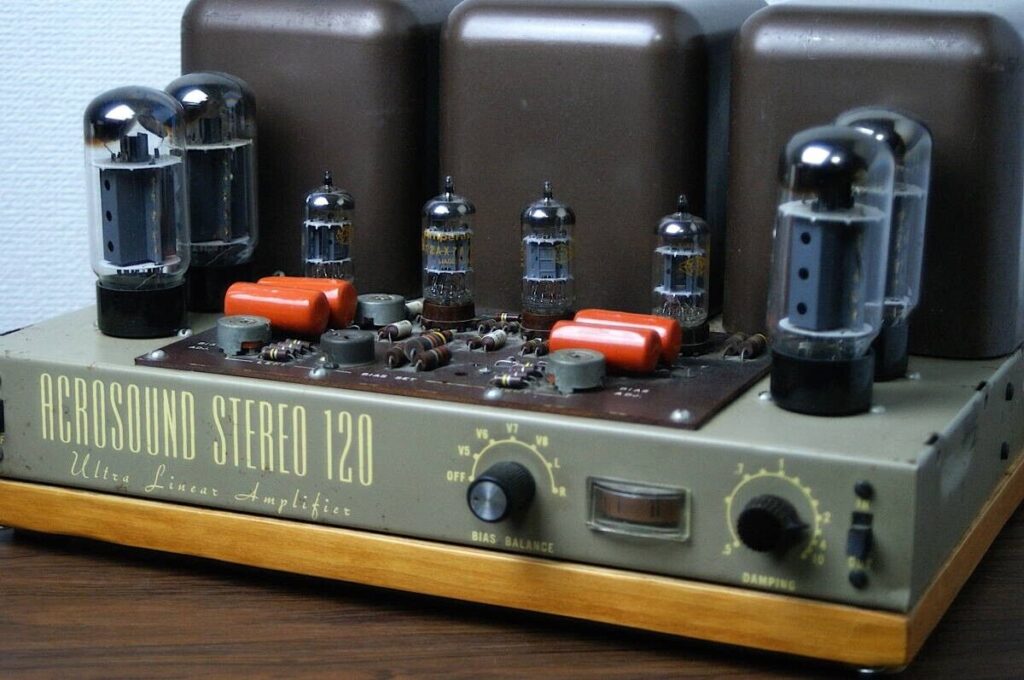


Founding of Dynaco
David Hafler teamed up with an engineer named Ed Laurent to found Dynaco in 1954. Their goal was to build affordable, high quality Hi-Fi equipment. Electronic kits and do-it-yourself projects were very popular at the time, so they made many of their products available in both assembled and kit form.
Dynaco started out by selling transformers, as evidenced by this August 1956 advertisement from Radio Electronics magazine.

But in that same magazine issue, the company placed an advertisement for the new “Dynakit Mark II” amplifier. The kit sold for USD$69.75 and employed 6CA7/EL-34 vacuum tubes, although the ad states that 6550 tubes could also be used. That little amplifier put out 50 watts with less than 1% distortion, which was a lot of power in those days. This was ideal for the new generation of acoustic suspension speakers, which were just beginning to appear at that time.

The launch of the Dynaco/Dynakit Mk II amplifier was the beginning of the Dynaco and Dynakit era, which lasted 25 years, ending when the company was shut down in 1980. Here are some of the company’s most iconic products.
Iconic Dynaco Products
Dynaco Mk II Amplifier
Dynaco got off to an auspicious start when they launched their first product, the “Mark II” amplifier, in 1955. It was a 50 watt amplifier powered by Mullard EL-34 tubes and used a Dynaco A-430 output transformer with both 4 ohm and 16 ohm “taps”. It was available pre-assembled or as a build-it-yourself “Dynakit”, and included all of the required tubes and a protective steel cage. The Mark II was a big seller, and established Dynaco’s reputation for great products and great value.


Dynaco PAM-1 Preamplifier
That same year, Dynaco released the “PAM-1” preamplifier. It was a simple, compact design using an external power supply. It was equipped with bass and treble adjustments, as well as a phono equalization control. Like most Dynaco products, it was available in assembled or kit form.


Dynaco Mark III Amplifier
After the success of the Mark II amplifier, Dynaco released the Mark III in 1957. The Mark III offered a number of improvement over the Mark II. The Mark II delivered around 50 watts per channel, while the Mark III delivered around 60 watts per channel. This increase in power allowed for better performance with more demanding speakers and improved overall sound dynamics. The Mark III used a more advanced output transformer, the Dynaco A-431, which was designed to handle the higher power output and provide better frequency response and lower distortion. The Mark III introduced an adjustable biasing circuit, which allowed users to fine-tune the bias settings of the output tubes. Proper biasing is crucial for achieving optimal performance and tube longevity. The physical design of the Mark III was also improved, with a more spacious chassis layout that allowed for better heat dissipation and easier maintenance. This made the amplifier more reliable and easier to work on for modifications or repairs.


Dynaco FM-1 FM Tuner
Dynaco released their first tuner, the FM-1, in 1957 as FM (Frequency Modulation) radio became more popular. It was available fully assembled or in kit form. When assembled from a kit, the owner was required to align the radio. It is remarkable that Dynaco was able to make this process simple enough for the do-it-yourself customer.

Dynaco PAS-1 Stereo Preamplifier
By the late 1950s, stereo records were becoming popular and people wanted to buy stereo components. Dynaco responded by releasing their first stereo component, the PAS-1. It was essentially two PAM-1 preamplifiers coupled together with a large faceplate. It was not an elegant solution and was not on the market for long.
Dynaco Stereo 70 Amplifier
Stereo sound continued to gain popularity and so in 1959, Dynaco launched its first stereo power amplifier, the Stereo 70 (sometimes called the ST-70). It was available as a kit for $99.95 or $129.95 fully assembled. The ST-70 went on to become one of the most popular amplifiers of all time. Dynaco sold about 500,000 units and many of these are still in service today. In fact, there are suppliers selling upgrade kits for those original Dynaco amplifiers, so you can keep your ST-70 running forever!
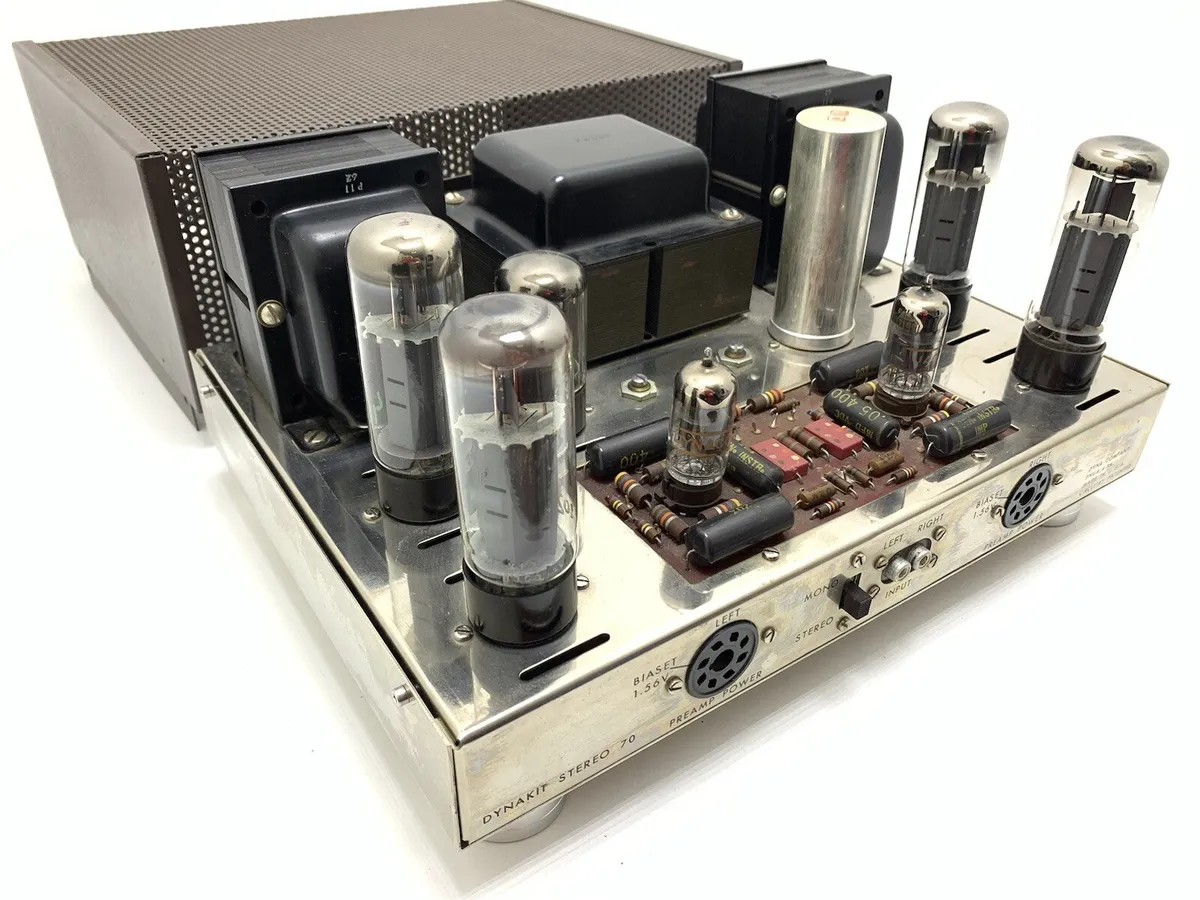
Dynaco PAS-2 Stereo Preamplifier
Dynaco developed a more elegant stereo preamplifier to pair with the ST-70. This was the PAS-2 which was introduced in 1959. It employed 12AX7 tubes for the phono and line amplification and sported a beautiful lacquered brass faceplate.

Dynaco Mark IV Amplifier
Despite the rise of stereo, there was still a demand for mono equipment, and Dynaco released the “Mark IV” power amplifier in 1960. It was a “beefier” version of the Stereo 70, and delivered 44 watts.

Dynaco SCA-35 Integrated Amplifier
In 1962 Dynaco produced a stereo integrated tube amplifier, the SCA-35, that combined a preamplifier with a modestly powered amplifier driven by EL84 vacuum tubes. It was a great solution for someone looking for a compact sized Hi-Fi system.
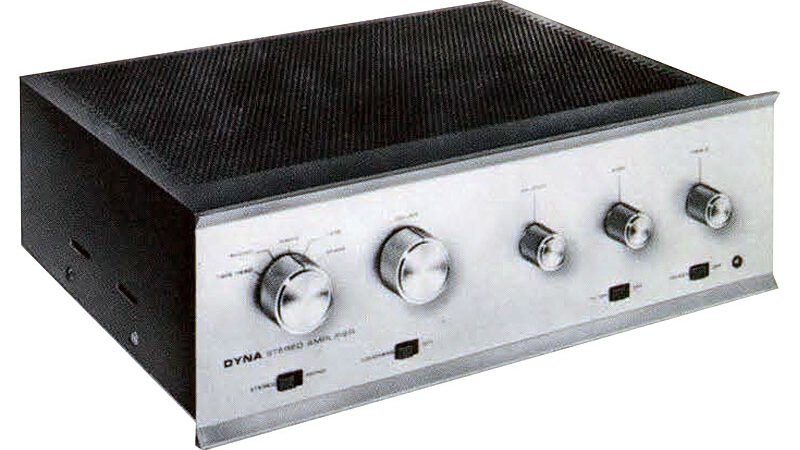
Dynaco ST-35 Amplifier and FM-3 Tuner
1963 saw the release of two more excellent components. The ST-35 was a smaller power amplifier, producing just 17.5 watts per channel. It was produced in small quantities, and there are very few in existence today (sorry, no photo). The same year, Dynaco released a new tuner, the FM-3, to take advantage of the newly released Federal Communications Commission (FCC) stereo standard. It employed the same rotary tuning dial as the FM-1.

Dynaco Stereo 120 Amplifier and PAT-4 Preamplifier
In the mid 1960s Dynaco responded to customer demand for solid state equipment by releasing their first transistorized designs, the Stereo 120 power amp and PAT-4 preamplifier. Because these were first generation solid state designs, they were not as polished as Dynaco’s tube equipment. Nonetheless, they sold well and many people are still enjoying these components today.


Dynaco FM-5 Stereo Tuner
In the late 1960s, as FM stereo broadcasts became more popular, Dynaco introduced the FM-5 tuner. It matched the other Dynaco components aesthetically, had a “slide rule” style tuning dial, was available assembled or in kit form, and delivered great performance.

Dynaco Loudspeakers
In the 1960s, David Hafler decided to get Dynaco into the speaker business. Their first speaker, the Dynaco A25, was developed in collaboration with Danish speaker manufacturer SEAS. It was designed to be an affordable yet high-performance loudspeaker that could compete with more expensive models, aligning with Hafler’s philosophy of delivering high-value audio products. Known as the Scan-Dyna A25 in Europe, it was tremendously successful. The Dynaco A25 was the very inductee into the Hi-Fi Hall of Fame! Click here to see the profile of this famous speaker.

Departure of David Hafler
David Hafler left Dynaco in 1968, shortly before the introduction of the Dynaco A25 speaker. Dynaco had become highly successful under Hafler’s leadership. The company and it’s Dynaco and Dynakit brands were known for their high-quality and affordable audio products, and the kits had a great reputation for being easy to assemble.
Nonetheless, by 1968 David Hafler had been in the electronics business for 18 years and he decided to sell the business. He sold Dynaco to Tyco, a large conglomerate that was involved in many technology-based businesses. Tyco managed Dynaco until around 1980, when the brand was shut down.
Founding of the David Hafler Company
Within a few years, Hafler was ready for another challenge. He founded a new business, called the David Hafler Company, with the same mission as Dynaco: to offer high-quality, high-fidelity audio equipment at an affordable price. Like Dynaco, the products would be available in both assembled and kit form. Unlike Dynaco, all of the products employed solid state technology.
Hafler hired Erno Borbely as his director of engineering and soon the company had launched two of Erno’s designs: the DH-101 preamplifier and the DH-200 stereo power amplifier.
David Hafler DH-101 and DH-200
The DH-200 had the distinction of being the first amplifier using a “MOSFET” output stage to be marketed in the U.S. MOSFETs were “metal oxide semiconductor field effect transistors” and they were superior to traditional transistors. The DH-200 used a total of four Hitachi MOSFETs per channel in “Class AB” mode to deliver 100 watts per channel. As with the Dynakits, the DH-200 kit came with two fully assembled and tested amplifier modules. Kit assembly consisted of assembling the case and wiring the power supplies, switches, and connectors. Affordability was always a major concern for Hafler. Cost in 1979 was $300 assembled and $200 as a kit. The DH-200 measured well, was faithful to its specs, and was known for its tight bass and durability. Best of all, it brought a powerful and high quality amplifier within reach of many audiophiles.
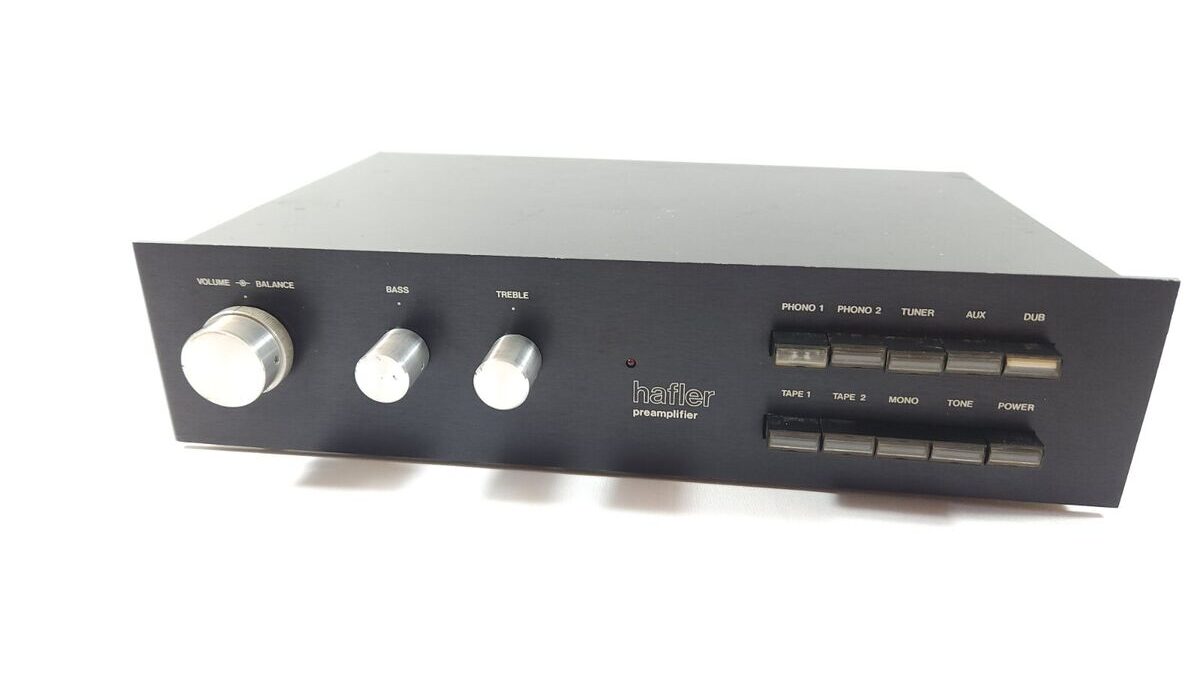

David Hafler DH-500 Power Amplifier
Later, the company offered the powerful DH-500 power amplifier, which was suitable for both home and professional studio applications. It was rated conservatively at 255 watts per channel.

David Hafler DH-220 Amplifier
Introduced in 1984, the DH-220 amplifier was a refinement of the DH-200 design, using the same fully complementary push-pull circuitry from input to output. It further enhanced Hafler’s reputation for good-sounding solid-state amplification. Often forgotten is the DH-220’s smaller brother, the DH-120. Rated at 60Wpc into 8 ohms, it was able to put out over 115Wpc on transient bursts.



David Hafler XL-280 “Excelinear” Amplifier
One of Hafler’s most fascinating amplifiers arrived in 1987. The XL-280 “Excelinear” featured a Class A input stage and a MOSFET-based output stage operating in Class AB, delivering 145Wpc into an 8-ohm load. The XL-280 stereo power amplifier was said to be the first amplifier to be designed using the “straight wire differential test”, which was intended to reveal the actual sound of the amplifier under test.

The much more powerful XL600 arrived about a year later. A real beast, it could pump out 360 watts per channel into 8 ohms, and up to 900 watts into a 1-ohm load.

In 1987, Hafler decided to retire from the business and the David Hafler company was sold to the Rockford Corporation, where chief engineer Jim Strickland continued the Hafler tradition for a few years.
Passing of David Hafler
David Hafler started his first Hi-Fi company in 1950, and left the industry when he sold the David Hafler company to Rockford. He was 68 at the time and had been in the Hi-Fi business for 37 years! He enjoyed a long retirement and passed away on May 25, 2003, at the age of 84.

David Hafler Impact on Hi-Fi
David Hafler and the companies that he founded have had a tremendous impact on Hi-Fi. He was a great engineer who developed simple, affordable audio components that could be assembled by any reasonably competent hobbyist. He was also a great businessman, transforming the electronic kit business. He was also a real audiophile who loved the hobby and created some timeless classic components that are still sought after today.
In fact, many of those vintage Dynaco components are so popular that there are businesses selling parts and restoration services to keep those old components running like new. Here are links to some of those companies if you’d like to check them out.
Dynaco ST-70 “Re-boots”
One Dynaco product, ST-70 amplifier, was so popular that after the demise of Dynaco, other companies created “re-boots” of the amplifier. A company called Panor created the “ST-70 Series II” in the 1990s.
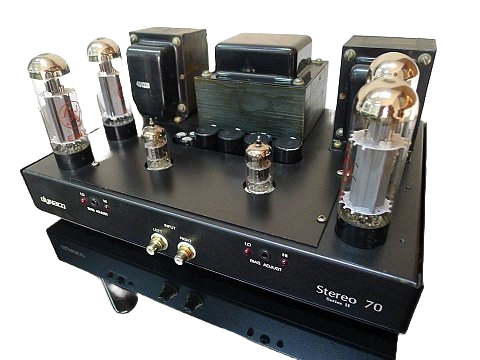
Many years later, a company called Radial Engineering bought the rights to the Dynaco name and created the “ST-70 Series 3”.

Induction to the Hi-Fi Hall of Fame
David Hafler, a visionary in the world of audio, is a deserving inductee into the Hi-Fi Hall of Fame. Renowned for his contributions to the evolution of audio technology, Hafler’s innovative spirit reshaped the way we experience sound.
Hafler’s genius lay in his ability to blend technical expertise with a keen understanding of the audiophile market, creating products that offered both exceptional performance and value. His emphasis on Do-It-Yourself kits allowed enthusiasts to build their own high-quality audio equipment, fostering a community of passionate audio hobbyists.
His legacy is one of innovation, accessibility, and a deep commitment to sound quality, and for these reasons David Hafler is inducted into the Hi-Fi Hall of Fame.






